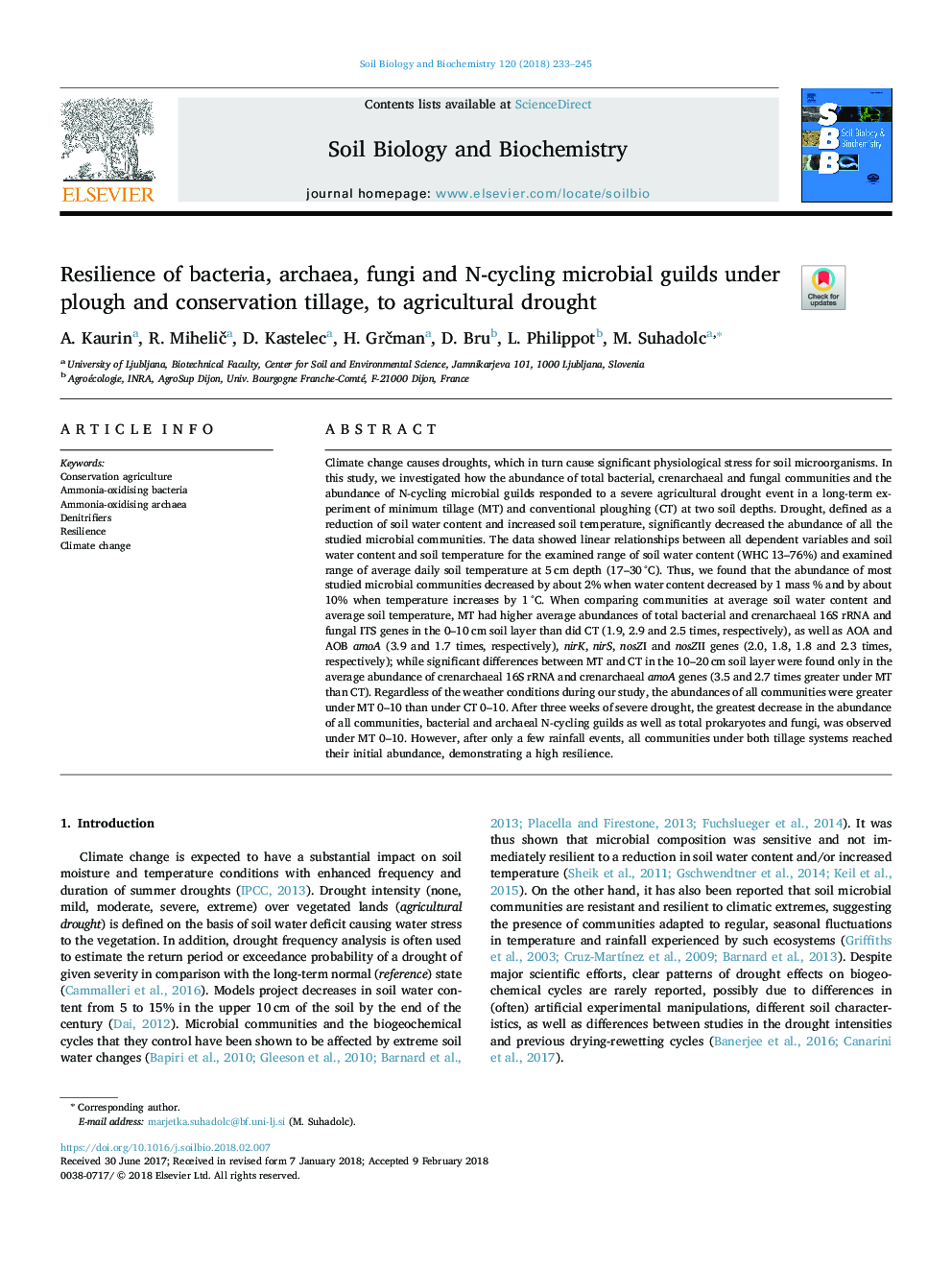| کد مقاله | کد نشریه | سال انتشار | مقاله انگلیسی | نسخه تمام متن |
|---|---|---|---|---|
| 8362850 | 1542564 | 2018 | 13 صفحه PDF | دانلود رایگان |
عنوان انگلیسی مقاله ISI
Resilience of bacteria, archaea, fungi and N-cycling microbial guilds under plough and conservation tillage, to agricultural drought
دانلود مقاله + سفارش ترجمه
دانلود مقاله ISI انگلیسی
رایگان برای ایرانیان
کلمات کلیدی
موضوعات مرتبط
علوم زیستی و بیوفناوری
علوم کشاورزی و بیولوژیک
دانش خاک شناسی
پیش نمایش صفحه اول مقاله

چکیده انگلیسی
Climate change causes droughts, which in turn cause significant physiological stress for soil microorganisms. In this study, we investigated how the abundance of total bacterial, crenarchaeal and fungal communities and the abundance of N-cycling microbial guilds responded to a severe agricultural drought event in a long-term experiment of minimum tillage (MT) and conventional ploughing (CT) at two soil depths. Drought, defined as a reduction of soil water content and increased soil temperature, significantly decreased the abundance of all the studied microbial communities. The data showed linear relationships between all dependent variables and soil water content and soil temperature for the examined range of soil water content (WHC 13-76%) and examined range of average daily soil temperature at 5â¯cm depth (17-30â¯Â°C). Thus, we found that the abundance of most studied microbial communities decreased by about 2% when water content decreased by 1 mass % and by about 10% when temperature increases by 1â¯Â°C. When comparing communities at average soil water content and average soil temperature, MT had higher average abundances of total bacterial and crenarchaeal 16S rRNA and fungal ITS genes in the 0-10â¯cm soil layer than did CT (1.9, 2.9 and 2.5 times, respectively), as well as AOA and AOB amoA (3.9 and 1.7 times, respectively), nirK, nirS, nosZI and nosZII genes (2.0, 1.8, 1.8 and 2.3 times, respectively); while significant differences between MT and CT in the 10-20â¯cm soil layer were found only in the average abundance of crenarchaeal 16S rRNA and crenarchaeal amoA genes (3.5 and 2.7 times greater under MT than CT). Regardless of the weather conditions during our study, the abundances of all communities were greater under MT 0-10 than under CT 0-10. After three weeks of severe drought, the greatest decrease in the abundance of all communities, bacterial and archaeal N-cycling guilds as well as total prokaryotes and fungi, was observed under MT 0-10. However, after only a few rainfall events, all communities under both tillage systems reached their initial abundance, demonstrating a high resilience.
ناشر
Database: Elsevier - ScienceDirect (ساینس دایرکت)
Journal: Soil Biology and Biochemistry - Volume 120, May 2018, Pages 233-245
Journal: Soil Biology and Biochemistry - Volume 120, May 2018, Pages 233-245
نویسندگان
A. Kaurin, R. MiheliÄ, D. Kastelec, H. GrÄman, D. Bru, L. Philippot, M. Suhadolc,